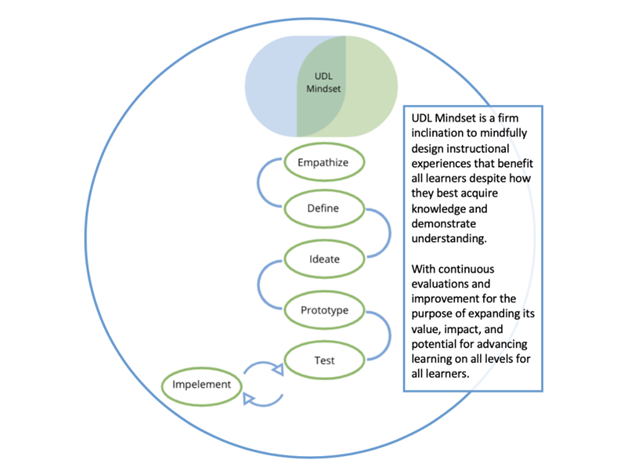ATD Blog
UDL + Design Thinking = Designing for All Learners
Wed Dec 16 2020

Universal Design for Learning (UDL) and design thinking frameworks advance instructional design practice and should frame design from the start. In the first steps of design thinking, effort is focused on understanding by empathizing with the users and exploring the users’ challenges. Then you start to identify by ideation with resulting prototyping steps. Following these, you test the prototypes and implement your new design for the users. In parallel, UDL also tries to empathize with your learners and prototype ways to deliver and assess content.
A UDL mindset fused with design thinking supports continuous improvement in which, after implementation, a designer will use continual improvement to deliver content, evaluate, make changes, deliver newly designed or updated content, and evaluate again in a cyclical manner.
Knowing Your Audience
Talent developers are often encouraged to know their audience. The first phase of the ADDIE model, analysis, is to assess what learners already need to know and what learners still need to know. However, a large percentage of learners who need accommodations remain unidentified. Further, the ways that learners absorb new knowledge and demonstrate learning of new knowledge can vary greatly because, most of the time, facilitators are unaware of their learners’ preferred way of learning. Therefore, a UDL mindset in an e-learning setting allows for a focus on access, not just accessibility.
Access Is More Than Accessibility
It’s important for designers to view course design through the lens of the various ways learners can access the knowledge they need to meet the learning objectives, as well as and different ways facilitators can assess learners’ understanding. Multiple ways for learners to access content allows facilitators to reach a wider portion of learners. Similarly, multiple ways for facilitators to assess learning allows for a wider representation of knowledge attainment. If the only way to assess learning is by writing a large paper, not all participants will be able to display the true ability of their new learning if writing is not their strength.
Sometimes the writing is what you are measuring. However, when it is not, it’s vital to allow participants various ways to demonstrate their learning. For example, if employees are learning how to keep a log needed for safety documentation, then the best way to assess that skill is to have employees show a completed log. If the goal is for employees to learn the components that make up a log and what each component contains, though, there are numerous ways for them to show understanding other than just writing. They may verbally present their understanding or work as a group with a jigsaw demonstration. An extensive list of examples of how to incorporate multiple means of engagement, representation, and action and expression into an online course that can easily be incorporated into e-learning in the workplace.
If you are a designer with a UDL mindset, you would approach assessing your learning objectives from the perspective of allowing a variety of ways for participants to show their understanding of course concepts. Then continue to evaluate and improve in cycles.
UDL and Design Thinking Model
By merging the principles of design thinking with the principles of UDL, the facilitator moves through the design process toward the success of all learners with continuous evaluation and improvement.

UDL Mindset Prototype Model showing Mindset, UDL, Design Thinking, and Cyclical Iterations for Continuous Improvement.
In the first step of design thinking, empathy, applied to UDL, the facilitator first empathizes with the learner’s experience going through the course, considering if the learner will perceive, learn, and retain the desired information to meet the learning objectives. In the next phase, define, the facilitator defines what problems the instruction will solve in ways that learners have multiple means of engagement, representation, and action and expression. During the ideate phase, the facilitator can step outside of normal instructional design and think of innovative ways to reach all learners—for example, having learners submit a short commercial video shot from their phones rather than a three-page paper to show mastery of a learning objective. During the prototype phase the facilitator may outline with sticky notes, drawn-out lesson plans, or designs within an online learning management system (LMS) to see how the different ways to provide content to learners, have participants demonstrate learning and facilitators ability to assess learning may look.
When the course goes live and participants move through the course, the facilitator uses continuous evaluation cycles to “test” and “implement” for continual improvement. These steps happen within the mindset framework and through the lens of UDL so that ALL learners have access to the content, access to demonstrating learning, and access to feedback for improvement.
Want to Learn More?
Join me at ATD TechKnowledge 2021 for the UDL Mindset in E-Learning Design session. We will explore how UDL is more than accessibility, it is a purposeful design for all participants, lessening the need for accommodations, and reaching all learners despite how they best acquire knowledge or demonstrate understanding.
